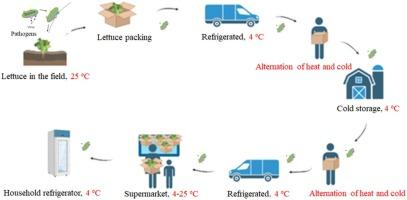超越冷链:探索温度波动下有机生菜上诺如病毒的细菌-病毒相互作用和消毒策略
IF 11.3
1区 环境科学与生态学
Q1 ENGINEERING, ENVIRONMENTAL
引用次数: 0
摘要
储存温度和微生物相互作用对新鲜农产品中诺如病毒的人类传播和食品安全至关重要。本研究考察了人类诺如病毒的替代品——鼠诺如病毒(MNV-1)和共污染细菌在有机生菜(一种重要载体)及其包装材料冷链运输过程中的存活情况,重点研究了温度波动和微生物相互作用。被假单胞菌sp. SC006[表达组织血型抗原(HBGA)的细菌]、大肠杆菌O157:H7和MNV-1污染的样品分别暴露于4℃、4 ~ 25℃波动温度和25℃恒定温度下。两种细菌都表现出温度依赖性生长,在25℃时增殖更快。MNV-1的存活率随温度的变化而变化,在较低的温度下持续时间更长。在温度波动期间,表达hbga的细菌增加了MNV-1的存活率。二氧化氯(ClO2,初始浓度为0.03%,pH为1.5)消毒实验表明,MNV-1与假单胞菌SC006的相互作用,特别是在SEPS-SC006中HBGA的高表达,对MNV-1有保护作用。ClO2 (180 ppm)和紫外线(UV, 200 mJ/cm2)联合处理有效地消毒了MNV-1,克服了本地细菌的耐药性。透射电镜(TEM)和分子对接分析显示,MNV-1颗粒与SEPS-SC006中hbga样物质结合,可能增强病毒耐药性。总体而言,温度波动和细菌-病毒相互作用会影响MNV-1的存活,而UV和ClO2的结合为确保整个食品冷链中的新鲜农产品安全提供了一种很有前途的方法。环境影响本研究强调了有机生菜冷链运输中温度波动和微生物相互作用对环境的影响。了解这些因素对于制定有效的消毒措施至关重要,例如UV和ClO2联合处理,可以减少病原体的存活并提高食品安全。通过降低与温度滥用和细菌-病毒相互作用相关的风险,这项研究有助于可持续和安全的食品供应链,最终有利于公众健康和环境。本文章由计算机程序翻译,如有差异,请以英文原文为准。

Beyond Cold Chain: Exploring Bacterial-Viral Interactions and Disinfection Strategies for Norovirus Persistence on Organic Lettuce under Temperature Fluctuations
Storage temperature and microbial interactions are critical to human norovirus transmission and food safety in fresh produce. This study examined the survival of murine norovirus (MNV-1), a surrogate of human norovirus, and co-contaminating bacteria on organic lettuce, being a significant vehicle, and its packaging materials during cold-chain transportation, focusing on temperature fluctuations and microbial interactions. Samples contaminated with Pseudomonas sp. SC006 [Histo-Blood Group Antigen (HBGA)-expressing bacteria], Escherichia coli O157:H7, and MNV-1 were exposed to 4°C, fluctuating temperatures between 4°C and 25°C, and a constant 25°C. Both bacteria showed temperature-dependent growth, proliferating faster at 25°C. MNV-1 survival varied with temperature, persisting longer at lower temperatures. HBGA-expressing bacteria increased MNV-1 survival during temperature fluctuations. Disinfection experiments using chlorine dioxide (ClO2, initial concentration of 0.03%, pH 1.5) revealed that the interaction between MNV-1 and Pseudomonas SC006, particularly the high expression of HBGA in SEPS-SC006, protected MNV-1. Combined ClO2 (180 ppm) and ultraviolet (UV, 200 mJ/cm2) treatment effectively disinfected MNV-1, overcoming resistance from indigenous bacteria. Transmission electron microscopy (TEM) and molecular docking analysis showed MNV-1 particles binding to HBGA-like substances in SEPS-SC006, potentially enhancing viral resistance. Overall, temperature fluctuations and bacterial-viral interactions affected MNV-1 survival, and the combination of UV and ClO2 offers a promising approach for ensuring fresh produce safety throughout the food cold chain.
Environmental Implications
This study highlights the environmental implications of temperature fluctuations and microbial interactions in the cold chain transportation of organic lettuce. Understanding these factors is crucial for developing effective disinfection measures, such as combined UV and ClO2 treatments, which can reduce pathogen survival and enhance food safety. By mitigating the risks associated with temperature abuse and bacterial-viral interactions, this research contributes to sustainable and safe food supply chains, ultimately benefiting public health and the environment.求助全文
通过发布文献求助,成功后即可免费获取论文全文。
去求助
来源期刊

Journal of Hazardous Materials
工程技术-工程:环境
CiteScore
25.40
自引率
5.90%
发文量
3059
审稿时长
58 days
期刊介绍:
The Journal of Hazardous Materials serves as a global platform for promoting cutting-edge research in the field of Environmental Science and Engineering. Our publication features a wide range of articles, including full-length research papers, review articles, and perspectives, with the aim of enhancing our understanding of the dangers and risks associated with various materials concerning public health and the environment. It is important to note that the term "environmental contaminants" refers specifically to substances that pose hazardous effects through contamination, while excluding those that do not have such impacts on the environment or human health. Moreover, we emphasize the distinction between wastes and hazardous materials in order to provide further clarity on the scope of the journal. We have a keen interest in exploring specific compounds and microbial agents that have adverse effects on the environment.
 求助内容:
求助内容: 应助结果提醒方式:
应助结果提醒方式:


